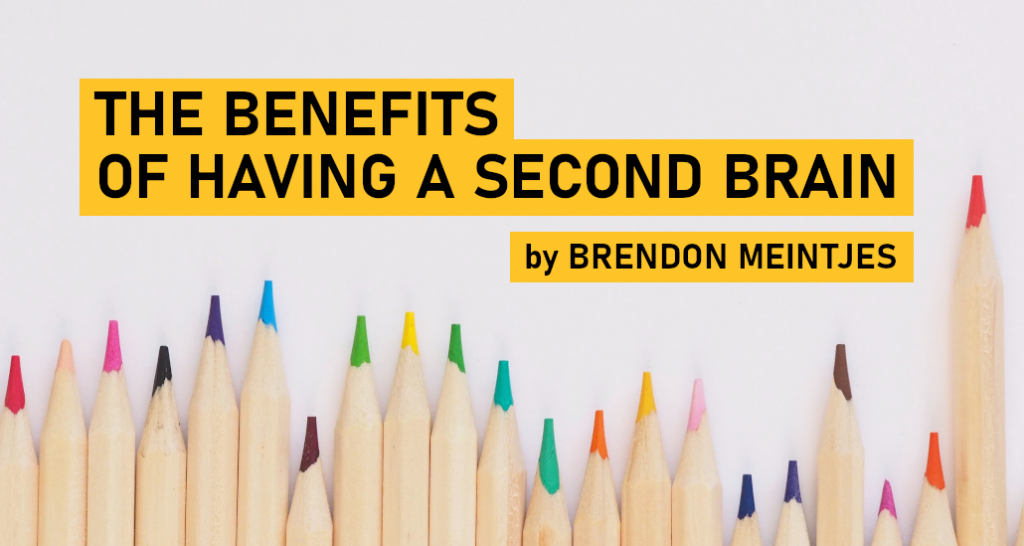Welcome to our third guest blog post! We are excited to host Brendon Meintjes as our guest author this week – his piece below explores the benefits of creating a Second Brain and how he uses his own to think “externally”.
We’ve all heard the expression “Two heads are better than one”, usually used to point out the benefits of teamwork and having multiple people tackling a shared problem. But what if the other person assisting you in your tasks could just be an externalised version of yourself?
Now I’m not talking about some way out there theory of cloning yourself or building an AI of yourself or anything that drastic. However, it is just as effective.
I recently read the book How to Take Smart Notes by Sönke Ahrens, you can see my review of it here, which discusses the process of using the Slip-Box Method to externalise your thinking and help you generate ideas and content across any aspect of your life.
“The Slip-Box Method” sounds exceptionally boring in my opinion, so I prefer to call this building a Second Brain.
I have already covered how to build a Second Brain in Notion in this article on my personal site – check it out!
Here I will be discussing how to use your very own “Second Brain” and the benefits I have gained from my short time of using mine.
How To Use Your Second Brain
Using your Second Brain will take some adjustment time in the beginning as you develop the habit of “thinking” externally. The actual process, however, is super simple and can be done in only a few short steps.
Step 1 – Make Fleeting Notes
Whenever you come across something that you find interesting or remarkable take a few seconds and make a brief note on what it is, where you came across it and the outline of the idea it generated for you.
This practice should not distract you from focusing on what you were already doing and is simply a reminder so you can get back to the mindset later. These fleeting notes can also be notes of things you think of while out for a walk, shopping etc.
Step 2 – Make Literature Notes
Literature notes are more extensive notes that you take while reading through content, or in a more digitally orientated world, it might be while listening to podcast or audiobooks.
Once again you are aiming to keep the notes as short as possible so be very selective on what you think is of value to you. The key feature here is that any notes you make must be in your own words. You can’t simply copy and paste something from the content you are taking in.
Step 3 – Make Permanent Notes
These are your final notes on any ideas you have from both fleeting notes as well as literature notes. These are the notes you will keep forever in your Second Brain and that link to other ideas of yours to start creating links between ideas, I like to call them Idea Chains.
These notes have to be generated from your own ideas and should never be copied and pasted from somewhere else. Putting ideas into your own words is vital so that when you come back and read them at later stages you can associate back to the idea and carry on the thought process at any point.
For this reason, it is also vital that 1 note = 1 idea. Don’t cover multiple ideas in one note, rather break them up into their parts and complete them this way. Only certain aspects will relate to other ideas that you have while using the system and the value of your Idea Chains is based on how specific you can be in each linked idea.
Your Second Brain’s Memory
So where do you file the above notes into your Second Brain?
Fleeting notes can either be destroyed once you have turned them into permanent notes or filed into the Reference Box. If you destroy them make sure that any references you had for having the idea are recorded and linked into the Reference Box first.
Literature notes always go into your Reference Box. This is because by nature they are related to external content and having the source of the info that generated your idea will always be valuable.
Your permanent notes are filed into your Slip-Box. Each permanent note should have its category noted as well as all links to other ideas validated so that your Idea Chains start to build up over time.
How to Get Ideas Out of Your Second brain
So this is obviously where the magic lies in this beautiful system. We have all tried to put some thought work together where it’s a research thesis, content to share online or even pitches for new developments at work.
The magic of the Second Brain is that you always get to start from a place of abundance. Anyone who has had to write a research paper will know that you usually follow a “Top Down” approach. This means you normally pick a topic and then have to find evidence to support the claims within that topic. This leads to months of research, battles of motivation and usually a lot of “This sucks!” as we struggle to fit everything together.
With the Second Brain, we approach it creating content through a “Bottom-Up” approach. As your Second Brain builds up Idea Chains you will have large amounts of supporting ideas already to work from. SO you rather see what you can substantiate and then choose a topic that fits into the evidence you already have. This usually means you can translate the related permanent notes into a rough draft, fill in the few gaps and then review it for your final product.
So How Has this system benefited me?
Now I’ve honestly only been using this system for roughly 2 months but I’ve noticed some great things out of it already.
The first is I’m more engaged with the content that I take in as I focus on what ideas I can generate from the content instead of previously where I used to simply read to take in the ideas of others.
It has also allowed me to come up with a lot of pre-started ideas that I want to share on this blog. Building up supporting evidence and related ideas each day as I add more into my Second Brain.
Finally, it has also freed up my mental space. Studies show that the average person can only hold 7 pieces of info in our short term memory. So by placing ideas onto fleeting notes and trusting the system I now have in place, I know that I won’t lose ideas and that all my ideas will be dealt with and turned into permanent notes. This frees up mental capacity for me and allows my brain to rather focus on the things that are important of my now deemed “main” brain, generating new ideas.
If any of you are already using the Slip-Box Method or adopt the Second Brain method I’ve discussed in this post, I’d love to hear your experience with it – you can connect with me via the links in the Author Bio below.
This article was originally published on Brendon Meintjes’ blog. Read more about his journey, thoughts and insights at https://www.brendonmeintjes.com/

Brendon Meintjes
Brendon is a recently qualified CA(SA). In 2020 he chaired the Johannesburg Article Clerk Association, more commonly referred to as JACASS.
He is now employed in the UK in a financial reporting role. He recently took the journey into digital expression with his own blog. In his spare time he is an avid reader and enjoys taking on new adventures.
Read more insights at www.brendonmeintjes.com or connect with him on Twitter, Instagram or LinkedIn.

Brendon Meintjes
Brendon is a recently qualified CA(SA). In 2020 he chaired the Johannesburg Article Clerk Association, more commonly referred to as JACASS.
He is now employed in the UK in a financial reporting role. He recently took the journey into digital expression with his own blog. In his spare time he is an avid reader and enjoys taking on new adventures.
Read more insights at www.brendonmeintjes.com or connect with him on Twitter, Instagram or LinkedIn.
Enjoying the site? Don’t miss our FREE CPD Newsletter – sign up below and stay updated weekly with free CPD content delivered directly to your inbox!
Sign up here:
Disclaimers:
Guest posts and comments represent the diversity of opinion within the Chartered Accounting profession and related industries. The views and opinions expressed in guest blog posts and articles are solely those of the author and do not necessarily reflect the official position of myCAhub™ who shall not be held liable for any inaccuracies presented.
Permissions: The author of any post presented on this site is responsible for obtaining all necessary permissions for publication.
Advice Disclaimer: myCAhub™ does not provide tax, legal, investment or accounting advice. This material has been prepared for informational purposes only, and is not intended to provide, and should not be relied on for, tax, legal , investment or accounting advice. You should consult your own tax, legal, investment and accounting advisors before engaging in any transaction or making any financial decisions.

